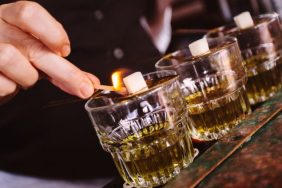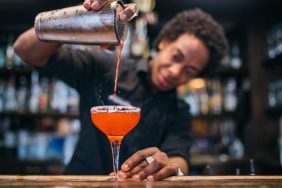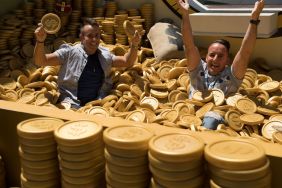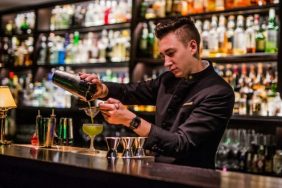Referred to in historical French writings as “La Fée Verte” (The Green Fairy), Absinthe is one of the most mysterious and forbidden spirits in the history of the world. The liquid is defined as a high-proof spirit that is flavored with anise and contains wormwood. It is often thought that wormwood is the reason absinthe was thought to have almost hallucinogenic qualities. It turns out that it’s inaccurately portrayed as such because of the wormwood oil experiments done by French psychiatrist Valentin Magnan in the 1800s. He studied 250 alcoholism sufferers and made a claim that drinkers who imbibed absinthe were far worse than those who drank other spirits. He also claimed that hallucinations were commonly found in these patients.
The History of Absinthe
Legend attributes the creation of an absinthe elixir to Madame Henroid of Couvet of Val de Travers, in the Canton of Neufchatel in Switzerland who concocted it from plants that she found in the mountains. “The elixir was adopted by Dr. Pierre Ordinaire who rode through the hills, peddling his ‘absinthe elixir’ which was so popular is became known as The Green Fairy,” says Jamie Gordon, Corporate Mixologist for Pernod Ricard USA.
Following the death of Dr. Ordinaire, the artisinal, rustic recipe was perfected by his two sisters. Afterwards, it was purchased by a businessman named Major Dubied, who saw the potential to brand the elixir for its supposed cure-all medicinal properties. Major Dubied hired Henri-Louis Pernod, a twenty-one year old distiller to help set up a small absinthe distillery in 1798.
Related: The Whisky Renaissance: Not Your Dad’s Scotch
In 1805, after he married the daughter of Major Dubied, Pernod moved across the border and founded the Maison Pernod Fils distillery in Pontarlier. By 1840, the family run business had doubled in size. The Pernod’s spirit began to gain in popularity swiftly due to its standing as the favorite drink of the bourgeois class, the military and the most famous artists, writers and thinkers of the time.
Absinthe’s Smear Campaign
Because of its enigmatic color and the unique ritual surrounding it, absinthe became of the strongest symbols of the era. “This popularity was envied by the wine lobby of France who began a severe and effective smear campaign against the spirit,” says Gordon. “The lobby fabricated and spread misinformation about absinthe’s ‘dangerous’ qualities. Among the most popular misconceptions is that absinthe is hallucinogenic. It is absolutely not a hallucinogenic, and has never been one.”

Although the claims were false, it didn’t stop what was already in motion. “Absinthe never was, nor ever will be, hallucinogenic.” Despite this fact, the campaign was so successful that by 1915 absinthe was banned in the United States and Europe. The Pernod factory closed its doors having seemingly lost the fight.
Five years later, the factory re-opened when a controlled form of anise liquors was legalized with a new absinthe-free Pernod recipe, an 80 proof alcohol anise spirit that is still sold today. For consumers in the US, only the legend of “The Green Fairy” remained until it was finally re-legalized again in 2007.
The Return of Absinthe
After extensive lobbying, absinthe was finally legalized again in the US in 2007. “Pernod Absinthe began production once more, and has once again become one of the top brands of absinthe in the country.”

In October of 2013, Pernod re-launched its absinthe with a whole new formula that was inspired by the original recipe from the 1800s. It took over two years for the distillery to develop the recipe and it includes a few changes. It’s distilled in copper stills from grape neutral base spirit and contains no artificial dyes. The coloring is 100% plant derived. Distillers can use other herbs and spices as well but anise and wormwood must be present. Pernod Absinthe (68%ABV) claims the title of being the “original absinthe,” as it was the first absinthe ever commercially produced and sold.
“The authentic wormwood is sourced from Pontarlier, France — the historic home of Pernod Absinthe.” Pernod’s Absinthe is now made in the iconic distillery designed by Gustav Eiffel in Thuir in the South of France, and will house the new “brand home,” a place where bartenders can visit to learn more about the brand and develop new cocktails.
Best Way to Drink Absinthe
The best way for a novice to drink absinthe is via the traditional absinthe fountain service. This is when ice water is dripped slowly over a sugar cube until the cube is completely dissolved into a measure of absinthe contained in the glass beneath it. “A ratio of about 4:1 (water: absinthe) with the sugar dissolved into the measure is ideal to allow the spirit’s light vegetal, anise, and citrus notes equal time on the palate,” says Gordon. As the Absinthe becomes more diluted, the drink will appear to be milky or cloudy. This chemistry effect has added to its spooky lore while also opening up or exposing the floral and herbal fragrances and tastes. This is the most historical and popular way to imbibe absinthe. It is often called the “French Method”.

Gordon also suggests adding a dash or two of absinthe to your favorite cocktail recipe to give it a kick. He says that there are many classic cocktails to add absinthe to that include Gimlets, Collins’, Sours and others for a so-called “improved cocktail.”
Gordon was introduced to the Spirits industry via a booming London cocktail scene already well-entrenched by the beginning of the 21st century. Starting as a touristing barback in the internationally-renowned LAB (London Academy of Bartenders) bar, Gordon spent two years working across The Big Smoke’s bar scene before landing in the Big Apple with the Absolut Spirits Company (acquired by Pernod Ricard in 2008) as a Brand Ambassador for New York. Now the Corporate Mixologist for Pernod Ricard USA, Jamie is a nationally recognized name within the cocktail trade, and has had his work featured across all forms of media. Jamie speaks as a cocktails and spirits educator domestically and internationally, and manages cocktail strategy and creation across the Pernod Ricard USA portfolio. He is based in New York.








